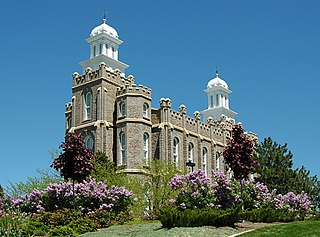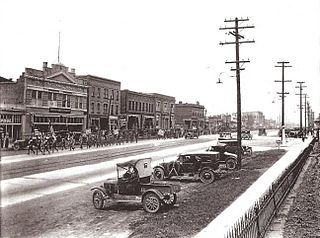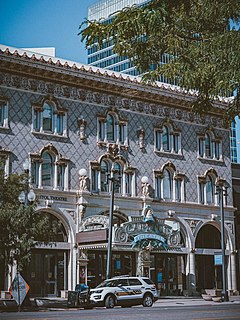
Magna is a metro township in Salt Lake County, Utah, United States. The current population of the township stands at 27,029 according to the 2020 census, a moderate increase over the 2000 figure of 22,770.

Murray is a city situated on the Wasatch Front in the core of Salt Lake Valley in the U.S. state of Utah. Named for territorial governor Eli Murray, it is the state's fourteenth largest city. According to the 2020 census, Murray had a population of 50,637. Murray shares borders with Taylorsville, Holladay, South Salt Lake and West Jordan, Utah. Once teeming with heavy industry, Murray's industrial sector now has little trace and has been replaced by major mercantile sectors. Known for its central location in Salt Lake County, Murray has been called the Hub of Salt Lake County. Unlike most of its neighboring communities, Murray operates its own police, fire, power, water, library, and parks and recreation departments and has its own school district. While maintaining many of its own services, Murray has one of the lowest city tax rates in the state.

Temple Square is a 10-acre (4.0 ha) complex, owned by The Church of Jesus Christ of Latter-day Saints, in the center of Salt Lake City, Utah. The usage of the name has gradually changed to include several other church facilities that are immediately adjacent to Temple Square. Contained within Temple Square are the Salt Lake Temple, Salt Lake Tabernacle, Salt Lake Assembly Hall, the Seagull Monument, and two visitors' centers. The square was designated a National Historic Landmark District in 1964, recognizing the Mormon achievement in the settlement of Utah.

Snowbasin Resort is a ski resort in the western United States, located in Weber County, Utah, 33 miles (53 km) northeast of Salt Lake City, on the back (east) side of the Wasatch Range.

The Joseph Smith Memorial Building, originally called the Hotel Utah, is a social center located on the corner of Main Street and South Temple in Salt Lake City. It is named in honor of Joseph Smith, the founder of the Latter Day Saint movement. It houses several restaurants and also functions as a venue for events. Several levels of the building also serve as administrative offices for The Church of Jesus Christ of Latter-day Saints departments such as FamilySearch. On January 3, 1978, it was added to the National Register of Historic Places as the Hotel Utah.

The Logan Utah Temple was completed in 1884, and is the fourth temple built by The Church of Jesus Christ of Latter-day Saints. Located in the city of Logan, Utah, it was the second temple built in the Rocky Mountains, after the St. George Temple, which remains the only Latter-day Saint temple that has been in operation longer than the Logan Temple.

The Warner Theatre is an Art-Deco style movie palace located at 68-82 Main Street in Torrington, Connecticut. It opened on August 19, 1931 as part of the Warner Bros. chain of movie theaters. Today it operates as a mixed-use performing arts center. It is individually listed on the National Register of Historic Places and also a contributing property in the Downtown Torrington Historic District.

The Tulsa Theater is a theater and convention hall located in Tulsa, Oklahoma. It was originally completed in 1914 and remodeled in 1930 and 1952. The building was used as a detention center during the 1921 Tulsa race massacre. It is listed on the National Register of Historic Places and remains in use as a theater today. The theater was previously named after W. Tate Brady but was renamed in 2019 due to Brady's affiliation with the Ku Klux Klan.

The Salt Lake Masonic Temple is the Masonic headquarters for Utah, and is Salt Lake City's best example of Egyptian Revival architecture. It was completed in 1927, and is located in the South Temple Historic District of Salt Lake City, Utah, United States.

The Victoria Theatre is a historic 1,154-seat performing arts venue located in downtown Dayton, Ohio. The Victoria presents traveling broadway shows, concerts and other theatrical productions such as The Phantom of the Opera.

The Ogden Theatre is a music venue and former movie theater in Denver, Colorado, United States. Located at 935 E. Colfax Avenue in the neighborhood of Capitol Hill, it was built in 1917 and has a maximum capacity of 1,600 for concerts. It is listed on the National Register of Historic Places.

This is a list of the National Register of Historic Places listings in Salt Lake County, Utah, except those in Salt Lake City. Listings for Salt Lake City can be found here.

This is a list of the National Register of Historic Places listings in Salt Lake City, Utah.

The Henry J. Wheeler Farm is a farmstead in Murray, Utah, United States, that is one of the few remaining late 19th century farmsteads in the Salt Lake Valley that has not been lost to expanding housing developments of metropolitan Salt Lake City. It has been listed on the National Register of Historic Places since 1976.

The Murray Downtown Historic District is located in the historic city center of Murray, Salt Lake County, Utah. It was listed on the National Register of Historic Places in 2006, with a boundary increase in 2020.

The Warenski-Duvall Commercial Building and Apartments, built in 1915, is a two-story brick, two part commercial block that is listed in National Register of Historic Places. The building is significant for its role in the early urbanization of Murray, Utah. The Warenski-Duvall building represents a building-type common during the early-twentieth century development of Murray's commercial business district and it is also part of the Murray Downtown Historic District. The building's owner was Edward J. Warenski, an early resident of Murray who owned a saloon and grocery store on State Street. Warenski and his family lived just north of the store. In 1923, the Duvall family purchased the building and divided the upper floor into apartments where family members and other workers in downtown Murray lived.

The Murray Downtown Residential Historic District is the best representative area of the residential settlement and development of the city of Murray, Utah, United States. It was listed on the National Register of Historic Places in 2005. It is locally significant as a physical reflection of its residential architecture and the historic development of the city from its agricultural beginnings through its industrial era and current status as a small suburban city. The buildings within the district represent the wide range of architectural styles and plans popular in the city and the state of Utah between 1870 and 1954 and retain a high degree of integrity.

Built in 1909, the Murray LDS Second Ward Meetinghouse is a historic building in Murray, Utah, United States. It was listed on the National Register of Historic Places in 2001. The building is significant for its association with the history and development of Murray between 1909 and 1950.
The Utah Theatre is a historic theater in Salt Lake City, Utah in the United States. It opened in 1918 as the Pantages Theater, after the name of its owner, Alexander Pantages. The theatre is located at 148 South Main Street, Salt Lake City.

The historic Capitol Theatre was built at 50 West 200 South in downtown Salt Lake City in 1913. Originally operated as a vaudeville house named Orpheum Theater, it was renamed Capitol Theater in 1927. It is also known currently as the JQ Lawson Capitol Theater. The building style is Italian Renaissance.





















